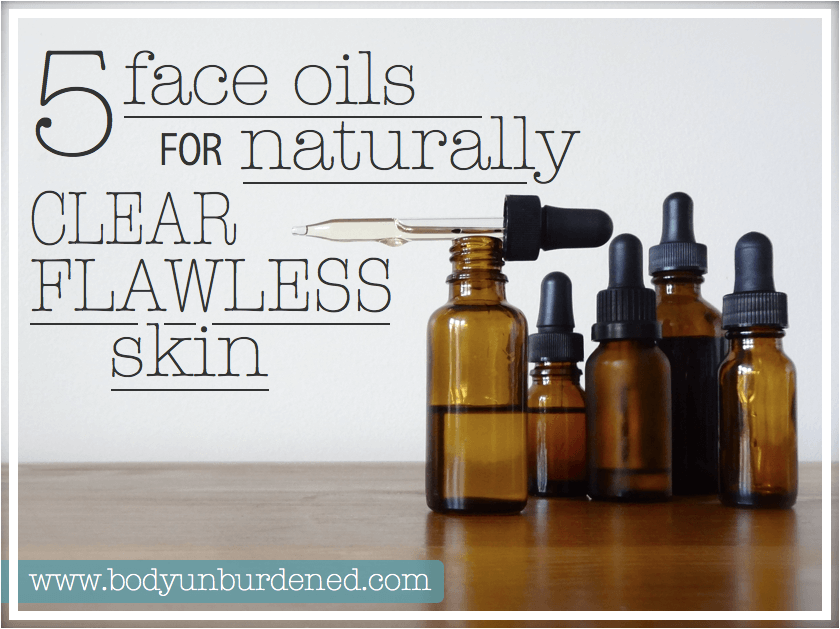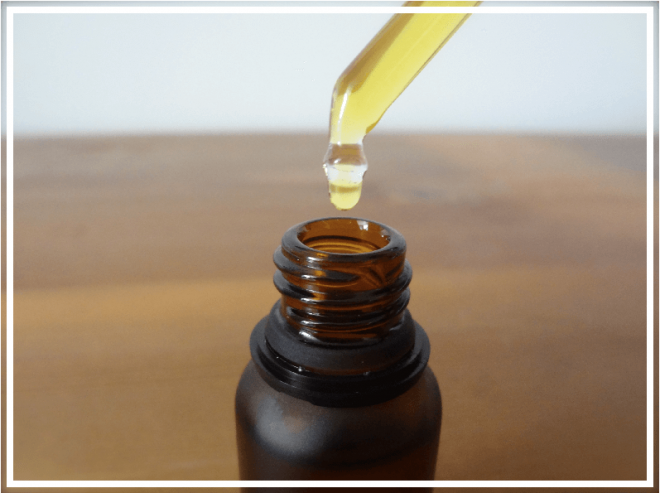5 face oils for naturally clear, flawless skin

I have a teeny-tiny little obsession…
With oil. That I put on my face.That’s right, I put oil on my face.
Now there was a time that I would have shuddered at the very idea. I went out of my way to scan every skincare product I purchased for “oil-free” before giving it the green light, thinking that any oil would instantly clog pores upon contact and turn me into one big walking blackhead. And when it came to dealing with breakouts, I saw oil as my ultimate enemy. I mean, I even wiped my face with rubbing alcohol at one point (*cringes*).
Ironically, it was in an act of acne-induced desperation that I finally gave oil a chance, and I’ve never looked back. Ever since accepting the fact that it is truly a remarkable, wonderful all-natural moisturizer that keeps skin clear and healthy, I’ve become obsessed with oil. So over the past however-many months, I’ve grown a little collection of face oils. Because the one oil that did work for me on my first shot (cha-ching!) was not enough. Oh no, I needed to try THEM ALL!
Well, a lot of them at least.
Needless to say, when I’m into something, I’m all in.
And because when I feel passionately about something I like to tell others about it (hence the purpose of this here blog), I’ve put together this list of the 5 oils that have helped me attain and maintain a clear, (as-close-to-)flawless(-as-I’ve-come-since-infancy) complexion.You may be wondering if coconut oil is on the list, and the answer is: no. The stuff is a staple in my house and I use it as a body moisturizer, but it makes my face break out. While it does work for some, it has a relatively high comedogenic rating which means it is very likely to clog pores.
So which oils made the list?
Jojoba oil
Jojoba oil was my first love. When I first started using it, all day I would look forward to bedtime so I could apply it again, knowing that I’d wake up the next morning with clearer skin (it’s a little sad but very true, and if you’ve ever been desperate for clear skin then you feel me).Jojoba oil is a light oil that is easily absorbed. It mimics the skin’s sebum, tricking it to produce less oil. While it does not feel that your skin has oil on it, I do not like wearing it alone during the day since it does give my face a slight sheen. That being said, I do mix it with the following dry oil and apply during the day…
Rosehip oil
 Rosehip oil
is my newest obsession. I confess that I decided to try rosehip oil
after learning that Rose Byrne — a.k.a. hilariously awful and beautiful
Helen from Bidesmaid — Kate Middleton, Gwyneth Paltrow, and Miranda Kerr all use this oil. You have to admit, these ladies have some lovely skin.
Rosehip oil
is my newest obsession. I confess that I decided to try rosehip oil
after learning that Rose Byrne — a.k.a. hilariously awful and beautiful
Helen from Bidesmaid — Kate Middleton, Gwyneth Paltrow, and Miranda Kerr all use this oil. You have to admit, these ladies have some lovely skin.Rosehip oil is a dry oil that penetrates to the deepest layers of the skin where it regenerates cells, increasing collagen production. It is rich in vitamin C, Omega-3 and Omega-6 fatty acids, all of which are known to help heal scar tissue. It is also high in retinoic acid, which studies show reduces the appearance of wrinkles and brightens skin.
Rosehip oil is without a doubt an integral part of my skincare routine, but do find it too drying to wear alone. Also, from my research it seems as though there can be a large discrepancy in the quality of certain rosehip oils, and the prices do certainly range quite a bit. It seems that it is worth spending more an a higher quality oil, such as the one I have been linking to here. This brand is the specific oil I have and have been using and with great results.
Castor oil
I tried using castor oil long before this face-oil-love-fest you’re witnessing right now, but didn’t stick with it. It is a very thick oil, and I didn’t like the fact that it felt like I had… well, oil on my face. That and it actually dried my skin out. This is because I was doing it all wrong; I was using just the castor oil. Less is definitely more when it comes to this oil: when a small amount of castor oil is mixed with another, thinner oil (such a jojoba — clearly my go-to!) the result is wonderful.Castor oil has anti-inflammatory and anti-bacterial properties, making it ideal for breakout-prone skin. It is high in unsaturated fatty acids, vitamin E, proteins, and minerals. In addition to helping reduce acne-causing bacteria and inflammation associated with breakouts, it can help heal discoloration and scars from acne.
Hemp seed oil
Hemp seed oil has a 0 comedogenic rating meaning it does not clog pores. I’ll say that again: this oil does not clog pores. The other oils on this list have a comedogenic rating of 1-2 out of 5, meaning that they may clog pores (but they won’t necessarily clog pores — it really depends on the person, and 1-2 is a low rating).Hemp seed oil helps to reduce the size of pores by helping to eliminate blackheads and acne. It also protects the skin from free radicals and improves elasticity. Because of its anti-inflammatory qualities, it is often recommended for the treatment of psoriasis and eczema. It is made up of 80% essential fatty acids (EFAs) and is said to contain the ideal ratio of Omega-6 to Omega-3 EFAs, which allows it to penetrate the layers of the skin.
Hemp seed oil is a very dry oil, and works best for me when mixed with a thick oil like castor oil or jojoba oil. The only thing I dislike about hemp seed oil is that it needs to be refrigerated after opening. And while I have a habit of applying masks in my kitchen in the reflection of the microwave that I very rarely use after steaming my pores open above a pot of water on the stove… there’s something about having to put your moisturizer on in the kitchen that makes me groan. That, and the fact that it’s cold when you apply it.
Tamanu oil
Like rosehip oil, tamanu oil helps regenerate skin tissue. For this reason, it is helps heal broken skin, and repair sun and acne damaged skin. It also has anti-inflammatory, antimicrobial, antibiotic, and antioxidant properties, making it ideal for acne sufferers. The thing that sets tamanu oil apart from the rest is a certain lipid called calophyllolide, which is not found in other oils and is a very strong anti-inflammatory.How to use these oils? Oh, the options are endless!
These face oils can be used on their own or mixed with each other in a blend that best suits your skin needs. These top 10 essential oils for skincare also make a great addition to your skin oil blend. Check them out and have LOTS OF FUN.This is the recipe for one of my personal favorite face oil blends: DIY all-natural face oil for acne-prone & oily skin.
I dare you to not become obsessed…
Note: I did not write this article, I found this article on the internet, thought it was great and re-posted on my blog.

No comments:
Post a Comment